- Laminate
- Ceramic/Porcelain
- Granite
- Engineered Stone
- Hardwood/Butcher Block
- Stainless Steel
- Solid Surface
- Marble
- Soapstone
- Concrete
Part 3
- Lava
- Copper
- Pewter
- Zinc
- Limestone
- Bamboo
- Lava Countertops
- Copper Countertops
- Pewter Countertops
- Zinc Countertops
- Limestone Countertops
- Bamboo Countertops
One of the newest entrants in countertop materials is lava rock (Figure 10). At the time of writing this article only one company, based in France was manufacturing countertops made of lava rock. Although there are distributors around the world.
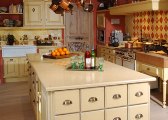
Figure 10 - Lava countertop
Advantages: Lava has all the qualities a homeowner would want in a countertop. It is very hard-wearing, resistant to most chemicals, is not affected by ultra-violet light, does not promote the growth of bacteria as it is not porous and hot objects can be placed on the surface without damaging the countertop.
Disadvantages: It is very expensive, in the order of $300 a square foot (a lot of the cost is due to shipping weight). Because it is a relatively new product, its life has not been confirmed, although there is no reason to doubt a long life.
Copper is one of the earliest metals used. Although it is not a common material for countertops, primarily because it requires craftsmen to form the edges and seam the metal properly. Copper countertops, (Figure 11), are a thin sheet of copper formed over plywood or composite material panels.
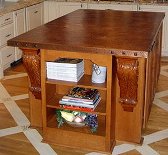
Figure 11 - Copper countertop
Advantages: Copper has a warmer aesthetic quality than metals such as stainless steel. Sinks can be welded to the countertop providing a seamless and hence waterproof countertop system. Copper is non-porous making it resistant to bacteria. Hot pots and pans will not affect the surface.
Disadvantages: Copper is a soft material and hence it dents easily and will show scratches. Over time, it copper countertops will change color (although many believe that this is an advantage). It must be sealed if the homeowner wants to maintain the shiny copper finish.
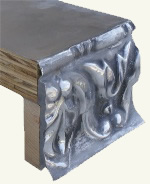
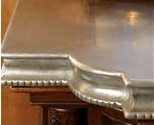
Figures 12a & 12b - Ornate pewter countertop edges
Unlike stainless steel, pewter has a regal appearance to it. It has been used for centuries to make goblets and other kitchen utensils. It has a matt finish unlike stainless steel that shines. Because it is a soft material it is relatively easy to shape and can be stamped to produce unique patterns and edges (Figures 12a & 12b). Pewter countertops (Figure 13) are made from a thin sheet of pewter material formed over plywood or composite material panels.
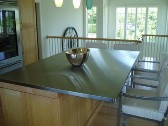
Figure 13 - Pewter countertop
Advantages: Handles hot pots and pans without damage. Easy to form and shape. Regal appearance. Unique in quality and appearance.
Disadvantages: Depending on the detail work, pewter countertops can easily run $400 to $500 a lineal foot. Older pewter was made with lead and any lead based products should never come in contact with any food items. Pewter is soft and dents easily. Very susceptible to wear and tear.
Note: Most of the Pewter sheet manufactured today does not use lead in its composition. But homeowners should verify that the Pewter sheets used by the company manufacturing their Pewter countertop are in fact lead free.
Zinc makes a somewhat unique countertop, (Figure 14). Overtime zinc will develop a grey-blue patina that is unmatched. Zinc countertops are a thin sheet of zinc formed over plywood or composite material panels.
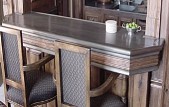
Figure 14 - Zinc countertop
Advantages: A zinc countertop can be welded to the sink making for a seamless and watertight seal. As a soft material it can be formed and stamped quite easily.
Disadvantages: As a soft material, a zinc countertop will dent and scratch very easily. Zinc, although not as durable as copper or stainless steel it will stand up to hot pots and pans.
Limestone should not be used in kitchens for floors or countertops because of its porosity, it cannot be sealed properly and becomes a haven for bacteria growth.
See our separate section on bamboo countertops
